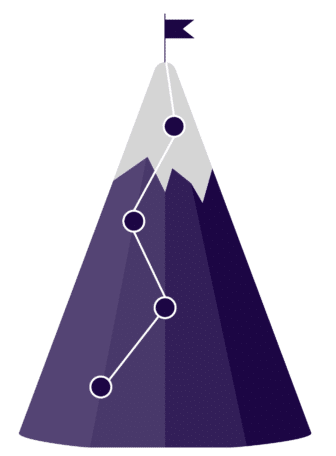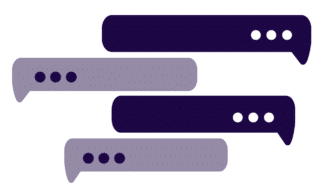Think your organization could benefit from a chatbot but not sure where to start? Or, are you curious to know if your organization would actually benefit from chatbot implementation? In this blog, I’ll review four necessary areas of consideration before beginning the chatbot design and development process, with specific questions and prompts to guide your thought process and get you closer to understanding how chatbots could, or should, add value to your organization.
In my last blog, I introduced the how of chatbots: how they work, how they’re implemented, and how they can help your organization, whether that’s through supporting your customer experience team, connecting users to information and research at the point of need, or request mapping. I also closed the blog with a line about the user experience that’s integral to successful chatbot implementation: “chatbots allow for a customized user experience, and not only allow users to get the information they need more quickly, but can be designed and oriented toward each user’s unique intent and interest.” This blog considers four key elements integral to creating a user-oriented chatbot experience. I’ve also included a selection of questions and considerations to ask yourself and your team before beginning the process of designing and developing the user experience of your chatbot.

Define Your Purpose
At the outset of your chatbot design and development process, you’ll want to define the chatbot’s purpose. Is it going to be oriented towards supporting your CX team or to connecting users to relevant research and publications? Part of your purpose will be pre-defined by the type of organization you are and the services you provide. When deciding what the purpose of your chatbot will be, consider areas of weakness in your organization and if those areas could benefit from chatbot-oriented services. A strong purpose statement can serve as your ‘north star’ throughout the development process and guide decision-making so that the end product aligns with your initial goal. Having a clear ‘north star’ purpose will also be invaluable throughout the necessary content clean-up and tagging process that happens prior to chatbot development. Additionally, the iterations and use case validations that occur during development should consistently be matched against, and support, your purpose.
Questions to consider:
- If you’re considering a phased approach to chatbot implementation, what do those phases look like? Does your purpose statement hold true during each of those phases of development?
- Some purpose statements include elements of both the emotional and the rational. Decide how you want your chatbot to make your users feel and consider not only what that looks like from a visual perspective, but the steps necessary to make that happen. What processes must your chatbot be able to carry out flawlessly? What is its main job? What is the use case for your chatbot?
 AI & Chatbots
AI & Chatbots
Artificial Intelligence (AI) chatbots have the ability to ‘learn’ in the sense that they’re designed to spot and track trends and patterns in data, like repeat user questions. The programming behind these chatbots is written in a way that not only tracks these patterns, but also applies those patterns where applicable, allowing the chatbot to most aptly service users’ needs without consistent human intervention. For example, consider a company that sells cell phones: user questions about a nonfunctioning power button or a cracked screen would both be routed to a physical repairs webpage.
Questions to consider:
- How ‘smart’ do you want your chatbot to be? Should it be able to notice and document patterns in user queries and adjust its responses in return or should it be designed to answer a set of targeted, but common, questions?
- What are the more advanced features you envision your chatbot offering? If its main purpose is to connect users to customer service representatives through a series of Boolean questions, you can go light on AI and machine learning capabilities.
- How often and with what resources are you willing or able to dedicate to your chatbot? A chatbot oriented around Boolean questions requires considerably less investment than a chatbot designed to ‘learn.’
Natural Language Interface/Conversational User Interface (CUI)

Chatbots allow users to interact with a computer interface on their own terms and in their own language, regardless of whether the chatbot’s communication process is triggered through Boolean operators (‘Did you want to cancel your internet services?’) or actual queries (‘What publications do we have about bridge development in Paraguay?’). And while Boolean operators limit the questions a user can ask of the chatbot and, in turn, what the chatbot understands, implementing a Boolean-oriented chatbot is an excellent option for a Proof of Concept to prove out a larger, more complex chatbot project.
Questions to consider:
- Related to both the AI section above and the Purpose section below, consider how conversational you need your chatbot to be. Spend some time brainstorming the types of questions you expect your users to ask, and then consider what questions would ‘break’ your bot. Be prepared to spend some time reworking your bot’s logic to address these breaking points. For instance, should your users be able to escape a bot-guided and intent-specific process? In one of our projects, users were finding that they couldn’t request help while looking at publications (i.e. the intent here is ‘view publications’). The bot’s conversational structure had to be reformatted to guide the user through the required steps to complete an intent before returning them to a point where they can choose a new intent.
- When your bot breaks (and it will), how should it respond and prompt the user to try another query? Does it recommend alternative or popular queries submitted by other users?
 Personalized Brand Experience
Personalized Brand Experience
The visual interface of the chatbot should be aligned with your organization’s branding guidelines so that it doesn’t appear to be adversely operating as a separate function of your organization’s user experience strategy. And because chatbots leverage a natural language interface, you’ll want to spend some time crafting the tone and formality of your chatbot’s responses so it interacts with your users in a language akin to your company’s brand and ethos. Your decisions here dictate how your chatbot will look, ‘speak,’ and behave.
Questions to consider:
- Is your organization’s branding up-to-date? Do your design and development teams have access to this branding? While this may seem like an obvious place to start any design process, it’s always a good idea to ascertain that everyone has access to the same, and correct, materials.
- Have you defined the ‘voice’ of your brand? If your brand were a person, how would they talk? Consider the vibe and tone you want conveyed through your chatbot’s ‘speech.’
Conclusion
With some dedicated thought and draftwork, the prompts featured above should help kickstart your organization’s chatbot design process. And while the above points are integral to the chatbot implementation process and can inform your organization’s initial design and development decisions, there’s some necessary data mapping and ontology design work that needs to happen behind the scenes so that your chatbot is both relevant and helpful. Use the prompts above to get a head-start on your chatbot’s design, and contact us if you’re interested in better understanding the chatbot implementation process from an end-to-end perspective.
